Viscoelastic Behavior of Polymer-Modified Cement Pastes: Insight from Downscaling Short-Term Macroscopic Creep Tests by Means of Multiscale Modeling
Abstract
:1. Introduction
2. Modeling the Hydration-Induced Evolutions of the Non-Aging Creep Properties of Polymer-Modified Cement Pastes
2.1. Micromechanical Representation of Polymer-Modified Cement Pastes
2.2. Viscoelastic Phase Properties
2.3. Homogenization of the Viscoelastic Properties of Polymer-Modified Cement Paste
3. Identification of Polymer Creep Properties Based on Macroscopic Creep Tests
3.1. Hourly-Repeated Ultra-Short Creep Tests on Polymer-Modified Cement Pastes
3.2. Universal Polymer Creep Properties
3.3. Age-Dependent Polymer Creep Properties
4. Conclusions
- The pronounced creep activity of polymer-modified cement paste can be explained by an isochoric power-law-type creep behavior of the polymers, whereby the shear creep modulus of the polymers is two orders of magnitude smaller than that of the hydrates.
- The creep behavior of the polymer particles inside hydrating cement paste is not universal. The creep activity of the polymer particles decreases significantly as hydration proceeds. The underlying physical mechanism is very likely related (i) to self-desiccation resulting from the (water-consuming) hydration reaction and (ii) to the associated continuous decrease of the internal relative humidity in cement pastes [62].
- The experimentally-observed macroscopic creep behavior of hydrating polymer-modified cement pastes can be satisfactorily reproduced when considering that the power-law creep exponent of the polymer particles is age-independent and, thus, constant. In that case, the shear creep modulus of the polymer particles was found to follow a bilinear trend during the first week after production. Considering that both the shear creep modulus and the creep exponent of the polymers are age-dependent and, thus, evolving functions, the agreement between modeling results and experiments can be further improved, but at the cost of considerable additional computational efforts.
- As for future research regarding the viscoelastic behavior of polymer-modified cement pastes, it is desirable to monitor the evolution of the internal relative humidity. This will provide the necessary physical background to interpret the self-desiccation-induced changes of the creep behavior of the polymers.
Acknowledgments
Author Contributions
Conflicts of Interest
Abbreviations
| elastic stiffness tensor of phase j | |
| clin | cement |
| cement paste | |
| cyl | cylindrical |
| experimentally-determined creep modulus of cement paste | |
| exp | experimentally-determined |
| hydrate foam-related volume fraction of phase j | |
| cement paste-related volume fraction of phase j | |
| hyd | hydrates |
| hydrate foam | |
| fourth-order identity tensor | |
| volumetric and deviatoric parts of the fourth-order identity tensor | |
| , | experimentally-determined and model-predicted uniaxial creep function of cement paste |
| , | viscous parts of , |
| fourth-order creep tensor function | |
| bulk modulus of phase j | |
| mod | model-predicted |
| P1, P2 | Polymer 1, Polymer 2 |
| p | complex variable in the LC domain |
| Hill tensor with shape m, | |
| pol | polymer |
| fourth-order relaxation tensor function | |
| fourth-order Eshelby tensor | |
| sph | spherical |
| t | chronological time |
| reference time | |
| power-law creep exponent of phase j | |
| experimentally-determined power-law exponent of cement paste | |
| gamma function | |
| Kronecker delta | |
| strain of phase j | |
| zenith angle | |
| shear modulus of phase j | |
| shear creep modulus of phase j | |
| degree of hydration | |
| stress of phase j | |
| time instant of loading | |
| azimuth angle | |
| LC transform of quantity (•) |
Appendix A. Phase Volume Fractions
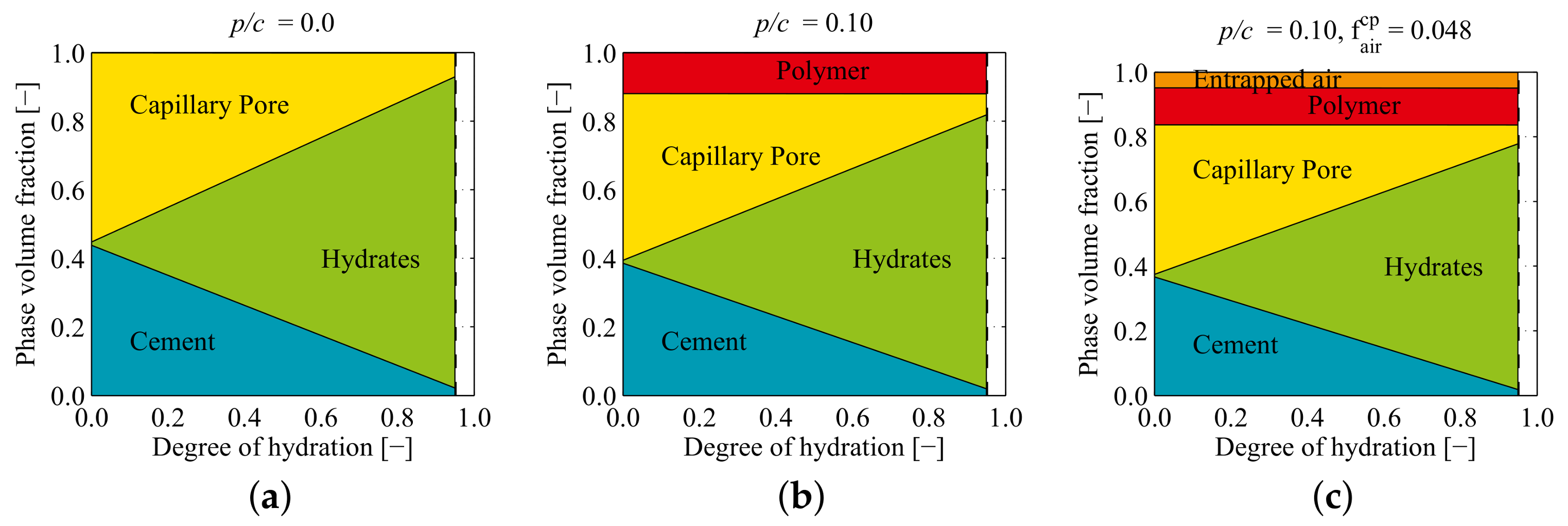
Appendix B. Hill Tensor Expressions in the LC Space
References
- Dimmig-Osburg, A. Innovations Based on PCC. Adv. Mater. Res. 2013, 687, 369–377. [Google Scholar] [CrossRef]
- Kim, D.G.; Lee, D.U.; Yang, E.I.; Cha, H. Durability of latex-modified concrete carried by ready-mix truck for concrete rooftops. Mag. Concr. Res. 2016, 68, 318–324. [Google Scholar] [CrossRef]
- Guo, Y.; Shen, A.; Shun, X. Exploring Polymer-Modified Concrete and Cementitious Coating with High-Durability for Roadside Structures in Xinjiang, China. Adv. Mater. Sci. Eng. 2017, 2017, 9425361. [Google Scholar] [CrossRef]
- Ohama, Y. Polymer-based Admixtures. Cem. Concr. Compos. 1998, 20, 189–212. [Google Scholar] [CrossRef]
- Bureau, L.; Alliche, A.; Pilvin, P.; Pascal, S. Mechanical characterization of a styrene-butadiene modified mortar. Mater. Sci. Eng. A 2001, 308, 233–240. [Google Scholar] [CrossRef]
- Al-Zahrani, M.M.; Maslehuddin, M.; Al-Dulaijan, S.U.; Ibrahim, M. Mechanical properties and durability characteristics of polymer- and cement-based repair materials. Cem. Concr. Compos. 2003, 25, 527–537. [Google Scholar] [CrossRef]
- Choi, P.; Yun, K.K. Experimental analysis of latex-solid content effect on early-age and autogenous shrinkage of very-early strength latex-modified concrete. Constr. Build. Mater. 2014, 65, 396–404. [Google Scholar] [CrossRef]
- Göbel, L.; Pichler, B.; Osburg, A. Early-age experimental characterization and semi-analytical modeling of elasticity and creep of polymer-modified cement pastes. In Proceedings of the Second International RILEM Conference on Early-Age Cracking and Serviceability in Cement-Based Materials and Structures, Brussels, Belgium, 12–14 September 2017. [Google Scholar]
- Göbel, L.; Pichler, B.; Osburg, A. The mechanical performance of polymer-modified cement pastes at early ages: Ultra-short non-aging creep tests and multiscale homogenization. Constr. Build. Mater. 2018, in press. [Google Scholar]
- Ito, M.; Aoki, S.; Hirata, T.; Hayakawa, K.; Abe, H.; Tottri, S. Development of high quality patching method by applying wet spraying, using polymer cement mortar and set accelerating agent. JSCE J. Constr. Eng. Manag. 2006, 62, 459–472. [Google Scholar] [CrossRef]
- Lee, J.H.; Kim, H.H.; Park, S.K.; Oh, R.O.; Kim, H.D.; Park, C.G. Mechanical Properties and Durability of Latex-Modified Fiber-Reinforced Concrete: A Tunnel Liner Application. Adv. Mater. Sci. Eng. 2018, 2018, 1–14. [Google Scholar] [CrossRef]
- Sercombe, J.; Hellmich, C.; Ulm, F.J.; Mang, H.A. Modeling of early-age creep of shotcrete. I: Model and Model Parameters. J. Eng. Mech. 2000, 126, 284–291. [Google Scholar] [CrossRef]
- Ullah, S.; Pichler, B.; Scheiner, S.; Hellmich, C. Shell-specific interpolation of measured 3D displacements, for micromechanics-based rapid safety assessment of shotcrete tunnels. Comput. Model. Eng. Sci. 2010, 57, 279–314. [Google Scholar]
- Woolson, I.H. Some remarkable tests indicating flow of concrete under pressure. Eng. News 1905, 54, 459–460. [Google Scholar]
- Hatt, W.K. Notes on the effect of time element in loading reinforced concrete beams. Proc. ASTM 1907, 7, 421–433. [Google Scholar]
- Bažant, Z.P.; Li, G.H. Comprehensive database on concrete creep and shrinkage. ACI Mater. J. 2008, 105, 635–637. [Google Scholar]
- Boulay, C.; Staquet, S.; Delsaute, B.; Carette, J.; Crespini, M.; Yazoghli-Marzouk, O.; Merliot, É.; Ramanich, S. How to monitor the modulus of elasticity of concrete, automatically since the earliest age? Mater. Struct. 2014, 47, 141–155. [Google Scholar] [CrossRef]
- Karte, P.; Hlobil, M.; Reihsner, R.; Dörner, W.; Lahayne, O.; Eberhardsteiner, J.; Pichler, B. Unloading-Based Stiffness Characterisation of Cement Pastes During the Second, Third and Fourth Day After Production. Strain 2015, 51, 156–169. [Google Scholar] [CrossRef]
- Irfan-ul Hassan, M.; Pichler, B.; Reihsner, R.; Hellmich, C. Elastic and creep properties of young cement paste, as determined from hourly repeated minute-long quasi-static tests. Cem. Concr. Res. 2016, 82, 36–49. [Google Scholar] [CrossRef]
- Delsaute, B.; Boulay, C.; Staquet, S. Creep testing of concrete since setting time by means of permanent and repeated minute-long loadings. Cem. Concr. Compos. 2016, 73, 75–88. [Google Scholar] [CrossRef]
- Delsaute, B.; Boulay, C.; Granja, J.; Carette, J.; Azenha, M.; Dumoulin, C.; Karaiskos, G.; Deraemaeker, A.; Staquet, S. Testing Concrete E-modulus at Very Early Ages Through Several Techniques: An Inter-laboratory Comparison. Strain 2016, 52, 91–109. [Google Scholar] [CrossRef]
- Irfan-ul Hassan, M.; Königsberger, M.; Reihsner, R.; Hellmich, C.; Pichler, B. How Water-Aggregate Interactions Affect Concrete Creep: A Multiscale Analysis. J. Nanomech. Micromech. 2017, 7, 4017019. [Google Scholar] [CrossRef]
- Bernard, O.; Ulm, F.J.; Lemarchand, E. A multiscale micromechanics-hydration model for the early-age elastic properties of cement-based materials. Cem. Concr. Res. 2003, 33, 1293–1309. [Google Scholar] [CrossRef]
- Hellmich, C.; Mang, H. Shotcrete Elasticity Revisited in the Framework of Continuum Micromechanics: From Submicron to Meter Level. J. Mater. Civil Eng. 2005, 17, 246–256. [Google Scholar] [CrossRef]
- Sanahuja, J.; Dormieux, L.; Chanvillard, G. Modelling elasticity of a hydrating cement paste. Cem. Concr. Res. 2007, 37, 1427–1439. [Google Scholar] [CrossRef]
- Pichler, B.; Hellmich, C.; Eberhardsteiner, J. Spherical and acicular representation of hydrates in a micromechanical model for cement paste: Prediction of early-age elasticity and strength. Acta Mech. 2009, 203, 137–162. [Google Scholar] [CrossRef]
- Pichler, B.; Scheiner, S.; Hellmich, C. From micron-sized needle-shaped hydrates to meter-sized shotcrete tunnel shells: Micromechanical upscaling of stiffness and strength of hydrating shotcrete. Acta Geotech. 2008, 3, 273–294. [Google Scholar] [CrossRef]
- Göbel, L.; Bos, C.; Schwaiger, R.; Flohr, A.; Osburg, A. Micromechanics-based prediction of the elastic properties of polymer-modified cementitious materials using nanoindentation and semi-analytical modeling. Cem. Concr. Compos. 2018, 88, 100–114. [Google Scholar] [CrossRef]
- Pichler, B.; Hellmich, C. Upscaling quasi-brittle strength of cement paste and mortar: A multi-scale engineering mechanics model. Cem. Concr. Res. 2011, 41, 467–476. [Google Scholar] [CrossRef]
- Pichler, B.; Hellmich, C.; Eberhardsteiner, J.; Wasserbauer, J.; Termkhajornkit, P.; Barbarulo, R.; Chanvillard, G. The counteracting effects of capillary porosity and of unhydrated clinker grains on the macroscopic strength of hydrating cement paste: A multiscale model. In Mechanics and Physics of Creep, Shrinkage, and Durability of Concrete; Ulm, F.J., Jennings, H.M., Pellenq, R., Eds.; American Society of Civil Engineers: Reston, VA, USA, 2013. [Google Scholar]
- Königsberger, M.; Hlobil, M.; Delsaute, B.; Staquet, S.; Hellmich, C.; Pichler, B. Hydrate failure in ITZ governs concrete strength: A micro-to-macro validated engineering mechanics model. Cem. Concr. Res. 2018, 103, 77–94. [Google Scholar] [CrossRef]
- Scheiner, S.; Hellmich, C. Continuum Microviscoelasticity Model for Aging Basic Creep of Early-Age Concrete. J. Eng. Mech. 2009, 135, 307–323. [Google Scholar] [CrossRef]
- Königsberger, M.; Irfan-ul Hassan, M.; Pichler, B.; Hellmich, C. Downscaling Based Identification of Nonaging Power-Law Creep of Cement Hydrates. J. Eng. Mech. 2016, 142, 4016106. [Google Scholar] [CrossRef]
- Tamtsia, B.T.; Beaudoin, J.J. Basic creep of hardened cement paste A re-examination of the role of water. Cem. Concr. Res. 2000, 30, 1465–1475. [Google Scholar] [CrossRef]
- Silva, D.A.; John, V.M.; Ribeiro, J.L.D.; Roman, H.R. Pore size distribution of hydrated cement pastes modified with polymers. Cem. Concr. Res. 2001, 31, 1177–1184. [Google Scholar] [CrossRef]
- Tian, Y.; Jin, X.Y.; Jin, N.G.; Zhao, R.; Li, Z.J.; Ma, H.Y. Research on the microstructure formation of polyacrylate latex modified mortars. Constr. Build. Mater. 2013, 47, 1381–1394. [Google Scholar] [CrossRef]
- Plank, J.; Gretz, M. Study on the interaction between anionic and cationic latex particles and Portland cement. Colloids Surf. A 2008, 330, 227–233. [Google Scholar] [CrossRef]
- Dimmig, A.; Rothenhäusser, B.; Sachsse, S. The influence of redispersibility and of the polymer powders composition on the freeze-thaw resistance of polymer modified mortar. In Proceedings of the 14th Internationale Baustofftagung, Weimar, Germany, 20–23 September 2000; pp. 1095–1103. [Google Scholar]
- Neville, A.M. Creep of concrete as a function of its cement paste content. Mag. Concr. Res. 1964, 16, 21–30. [Google Scholar] [CrossRef]
- Bažant, Z.P.; Prasannan, S. Solidification Theory for concrete creep. I: Formulation. J. Eng. Mech. 1989, 115, 1691–1703. [Google Scholar] [CrossRef]
- Acker, P. Micromechanical Analysis of Creep and Shrinkage Mechanisms. In Proceedings of the Sixth International Conference Creep, Shrinkage and Durability Mechanics of Concrete and Other Quasi-brittle Materials, Cambridge, MA, USA, 20–22 August 2001; pp. 15–26. [Google Scholar]
- Schwarzl, F.R.; Struik, L. Analysis of relaxation measurements. Adv. Mol. Relax. Processes 1968, 1, 201–255. [Google Scholar] [CrossRef]
- Constantinides, G.; Ulm, F.J. The effect of two types of C-S-H on the elasticity of cement-based materials: Results from nanoindentation and micromechanical modeling. Cem. Concr. Res. 2004, 34, 67–80. [Google Scholar] [CrossRef]
- Velez, K.; Maximilien, S.; Damidot, D.; Fantozzi, G.; Sorrentino, F. Determination by nanoindentation of elastic modulus and hardness of pure constituents of Portland cement clinker. Cem. Concr. Res. 2001, 31, 555–561. [Google Scholar] [CrossRef]
- Zaoutsos, S.P.; Papanicolaou, G.C.; Cardon, A.H. On the non-linear viscoelastic behaviour of polymer-matrix composites. Compos. Sci. Technol. 1998, 58, 883–889. [Google Scholar] [CrossRef]
- Kapnistos, M.; Lang, M.; Vlassopoulos, D.; Pyckhout-Hintzen, W.; Richter, D.; Cho, D.; Chang, T.; Rubinstein, M. Unexpected power-law stress relaxation of entangled ring polymers. Nat. Mater. 2008, 7, 997–1002. [Google Scholar] [CrossRef] [PubMed]
- Chevali, V.S.; Dean, D.R.; Janowski, G.M. Flexural creep behavior of discontinuous thermoplastic composites: Non-linear viscoelastic modeling and time-temperature-stress superposition. Compos. Part A 2009, 40, 870–877. [Google Scholar] [CrossRef]
- Laws, N.; McLaughlin, R. Self-Consistent Estimates for the Viscoelastic Creep Compliances of Composite Materials. Proc. R. Soc. Lond. A 1978, 359, 251–273. [Google Scholar] [CrossRef]
- Zaoui, A. Continuum mechanics: A survey. J. Eng. Mech. 2002, 128, 808–816. [Google Scholar] [CrossRef]
- Hershey, A.V. The elasticity of an isotropic aggregate of anisotropic cubic crystals. J. Appl. Mech. 1954, 21, 236. [Google Scholar]
- Powers, T.C.; Brownyard, T.L. Studies of the Physical Properties of Hardened Portland Cement Paste. Res. Lab. Portland Cem. Assoc. Bull. 1948, 43, 101–132. [Google Scholar]
- Mori, T.; Tanaka, K. Average stress in matrix and average elastic energy of materials with misfitting inclusions. Acta Metall. 1973, 21, 571–574. [Google Scholar] [CrossRef]
- Benveniste, Y. A new approach to the application of Mori-Tanaka’s theory in composite materials. Mech. Mater. 1987, 6, 147–157. [Google Scholar] [CrossRef]
- Abate, J.; Valkó, P.P. Multi-precision Laplace transform inversion. Int. J. Numer. Methods Eng. 2004, 60, 979–993. [Google Scholar] [CrossRef]
- Valkó, P.P.; Abate, J. Comparison of sequence accelerators for the Gaver method of numerical Laplace transform inversion. Comput. Math. Appl. 2004, 48, 629–636. [Google Scholar] [CrossRef]
- Göbel, L.; Pichler, B.; Osburg, A. Experimental analysis and micromechanics-based prediction of the elastic and creep properties of polymer-modified concrete at early ages. In Proceedings of the 16th International Congress on Polymers in Concrete 2018, Washington, DC, USA, 29 April–1 May 2018. [Google Scholar]
- Wang, R.; Wang, P.M.; Li, X.G. Physical and mechanical properties of styrene–butadiene rubber emulsion modified cement mortars. Cem. Concr. Res. 2005, 35, 900–906. [Google Scholar] [CrossRef]
- Doğan, M.; Bideci, A. Effect of Styrene Butadiene Copolymer (SBR) admixture on high strength concrete. Constr. Build. Mater. 2016, 112, 378–385. [Google Scholar] [CrossRef]
- Maksimov, R.D.; Sokolov, E.A.; Mochalov, V.P. Effect of temperature and humidity on the creep of polymer materials. Polym. Mech. 1975, 11, 834–839. [Google Scholar] [CrossRef]
- Scaffaro, R.; Tzankova Dintcheva, R.; La Mantia, F.P. A new equipment to measure the combined effects of humidity, temperature, mechanical stress and UV exposure on the creep behaviour of polymers. Polym. Test. 2008, 27, 49–54. [Google Scholar] [CrossRef]
- Liu, X.; Wildman, R.D.; Ashcroft, I.A. Experimental investigation and numerical modelling of the effect of the environment on the mechanical properties of polyurethane lacquer films. J. Mater. Sci. 2012, 47, 5222–5231. [Google Scholar] [CrossRef]
- Lura, P.; Jensen, O.M.; van Breugel, K. Autogenous shrinkage in high-performance cement paste: An evaluation of basic mechanisms. Cem. Concr. Res. 2003, 33, 223–232. [Google Scholar] [CrossRef]
- Bijen, J.; Su, Z. Polymer cement concrete: A contribution to modling of the microstructure. In Proceedings of the TC 113, Symposium on properties and test methods for concrete-polymer composites, Oostende, Belgium, 6 July 1995; pp. 19–27. [Google Scholar]
- Dimmig-Osburg, A. Microstructure of PCC—Effects of polymer components and additives. In Proceedings of the 12th International Congress on Polymers in Concrete, Cairns, Australia, 27–28 September 2009. [Google Scholar]
- Kong, X.; Pakusch, J.; Jansen, D.; Emmerling, S.; Neubauer, J.; Goetz-Neuhoeffer, F. Effect of polymer latexes with cleaned serum on the phase development of hydrating cement pastes. Cem. Concr. Res. 2016, 84, 30–40. [Google Scholar] [CrossRef]
- Wang, R.; Li, X.G.; Wang, P.M. Influence of polymer on cement hydration in SBR-modified cement pastes. Cem. Concr. Res. 2006, 36, 1744–1751. [Google Scholar] [CrossRef]
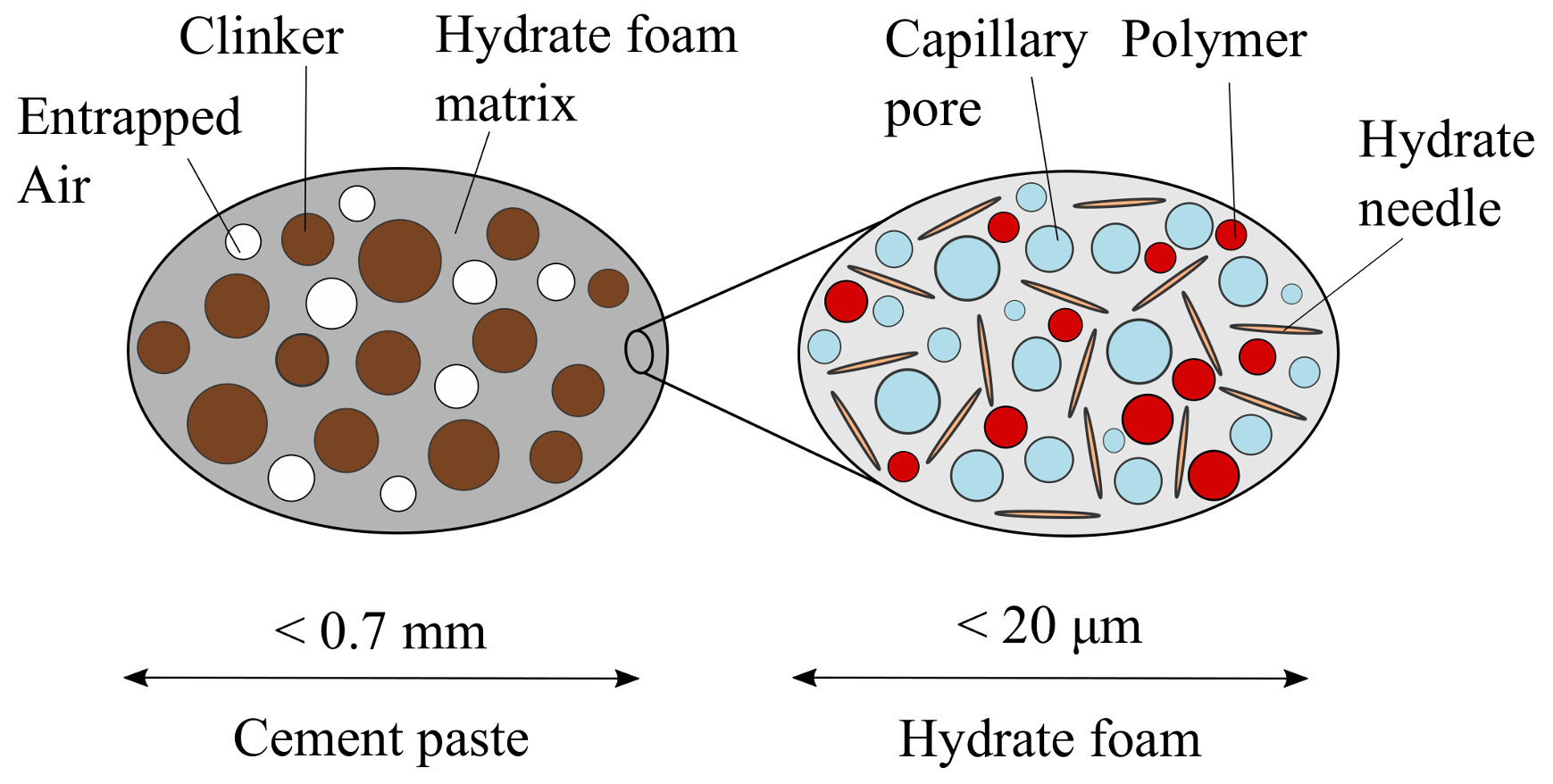

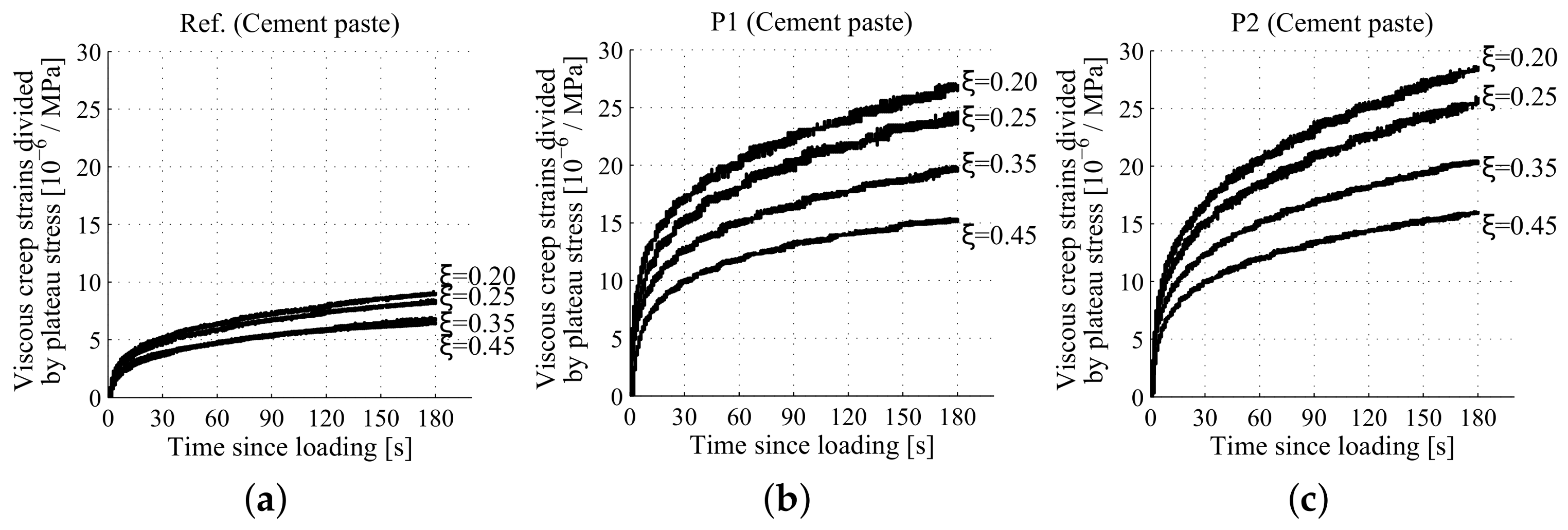
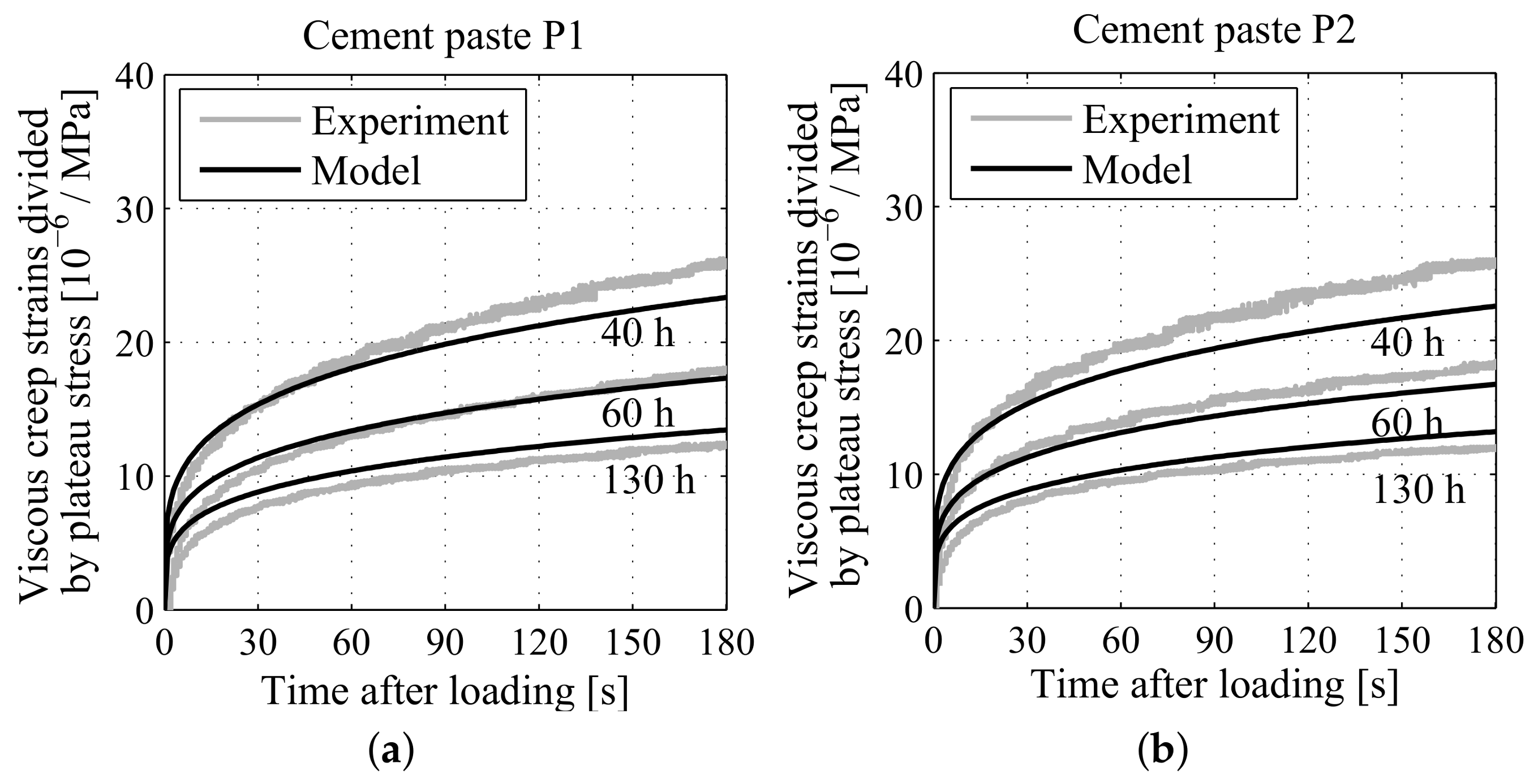
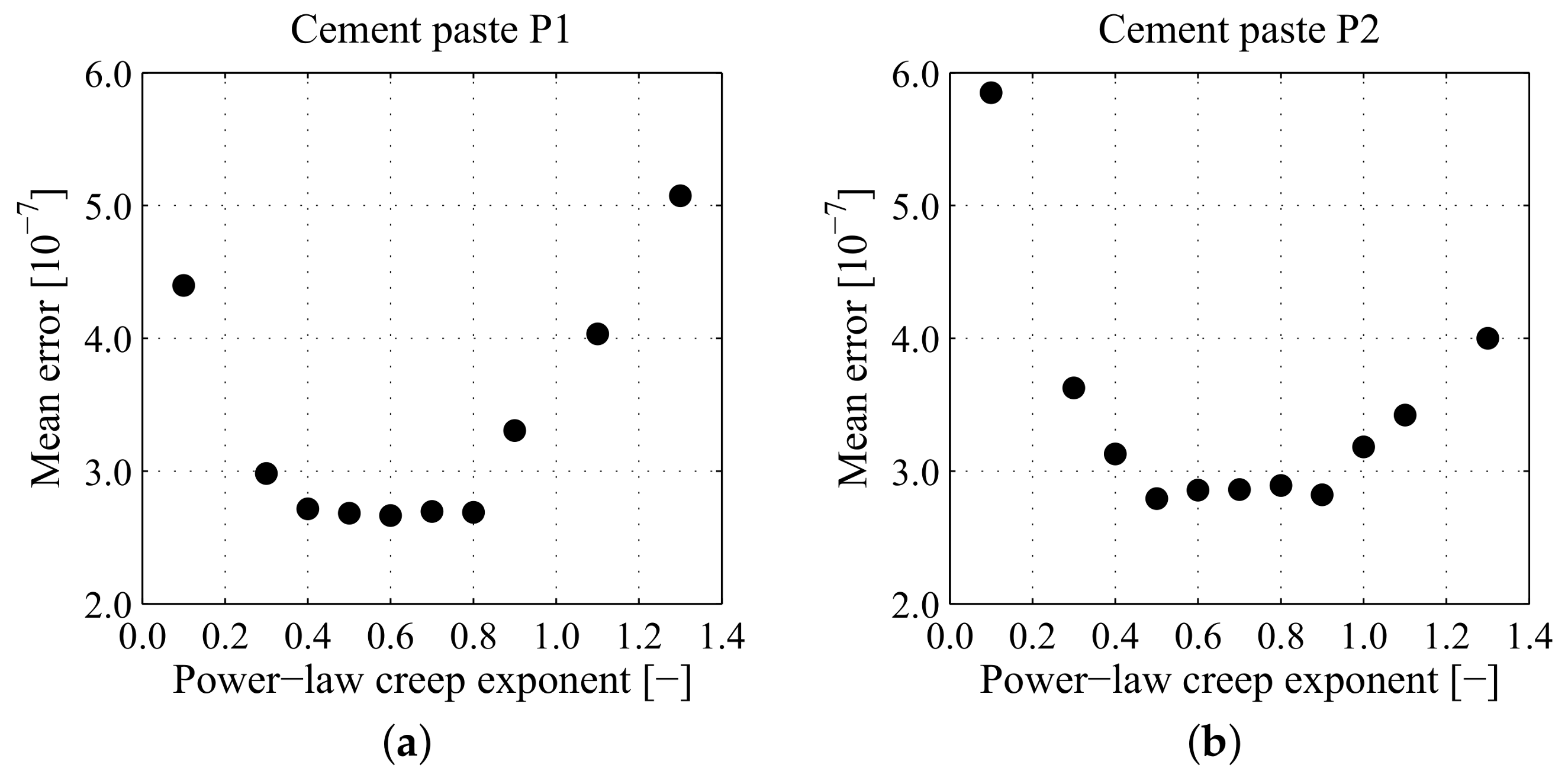
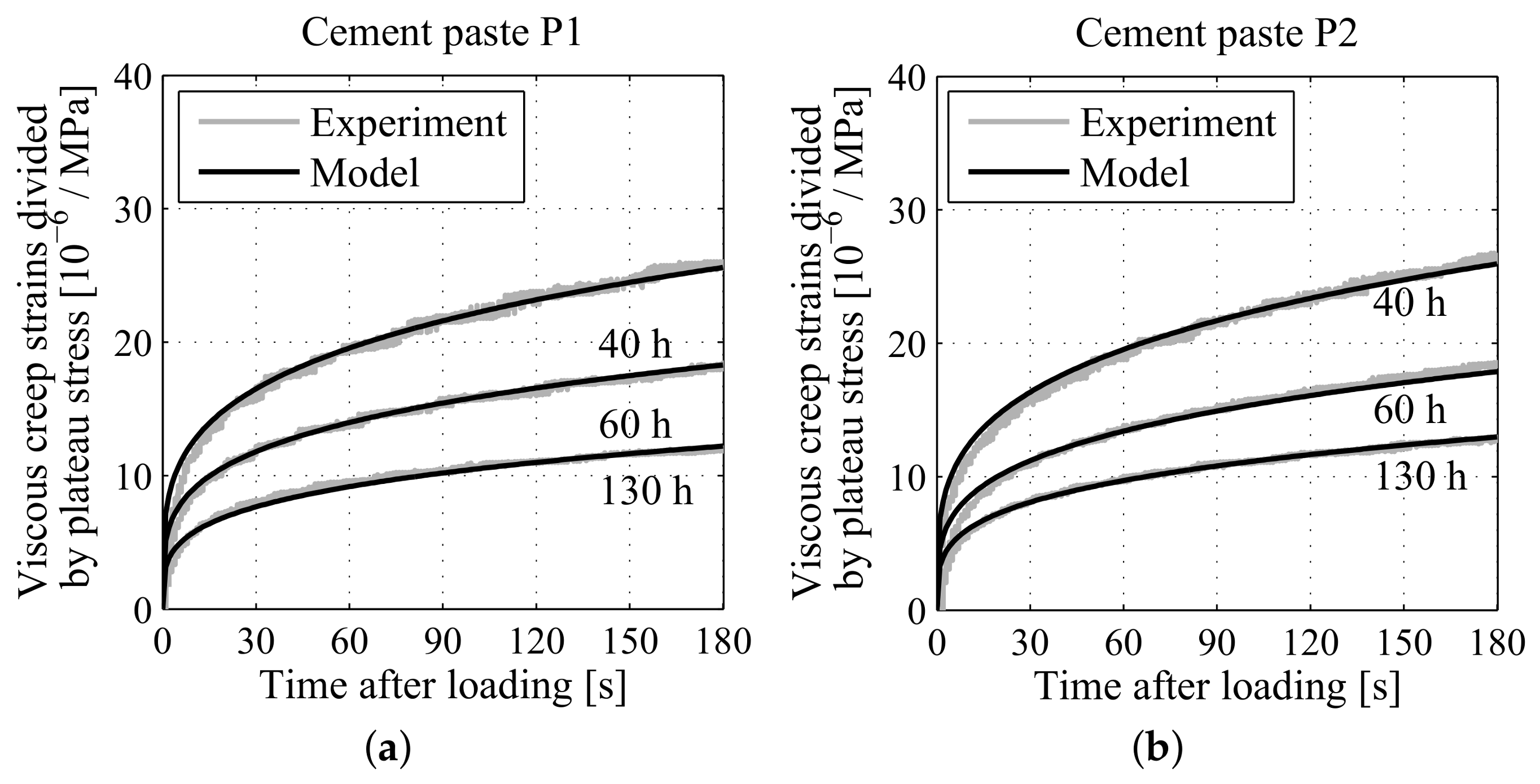
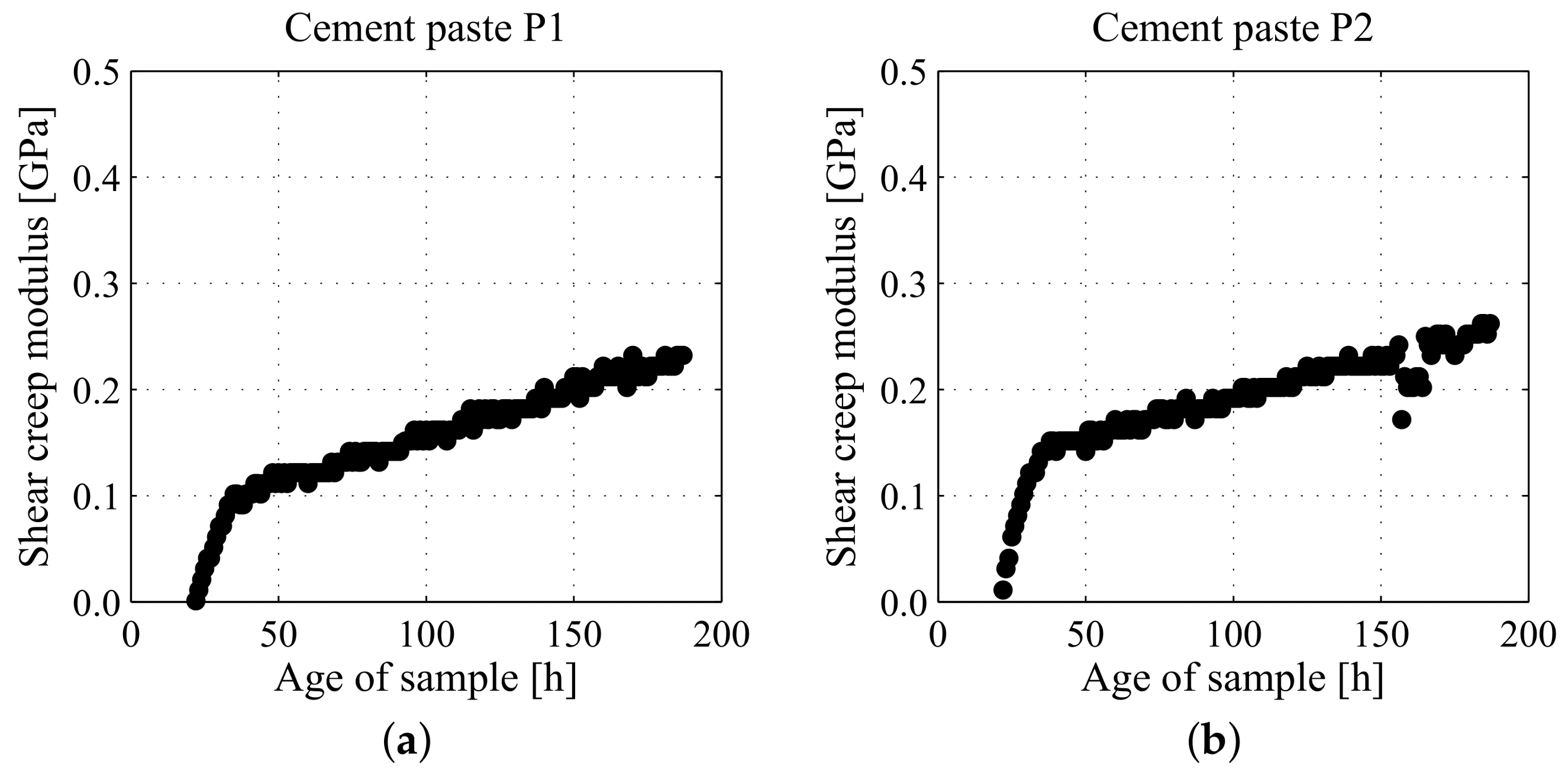
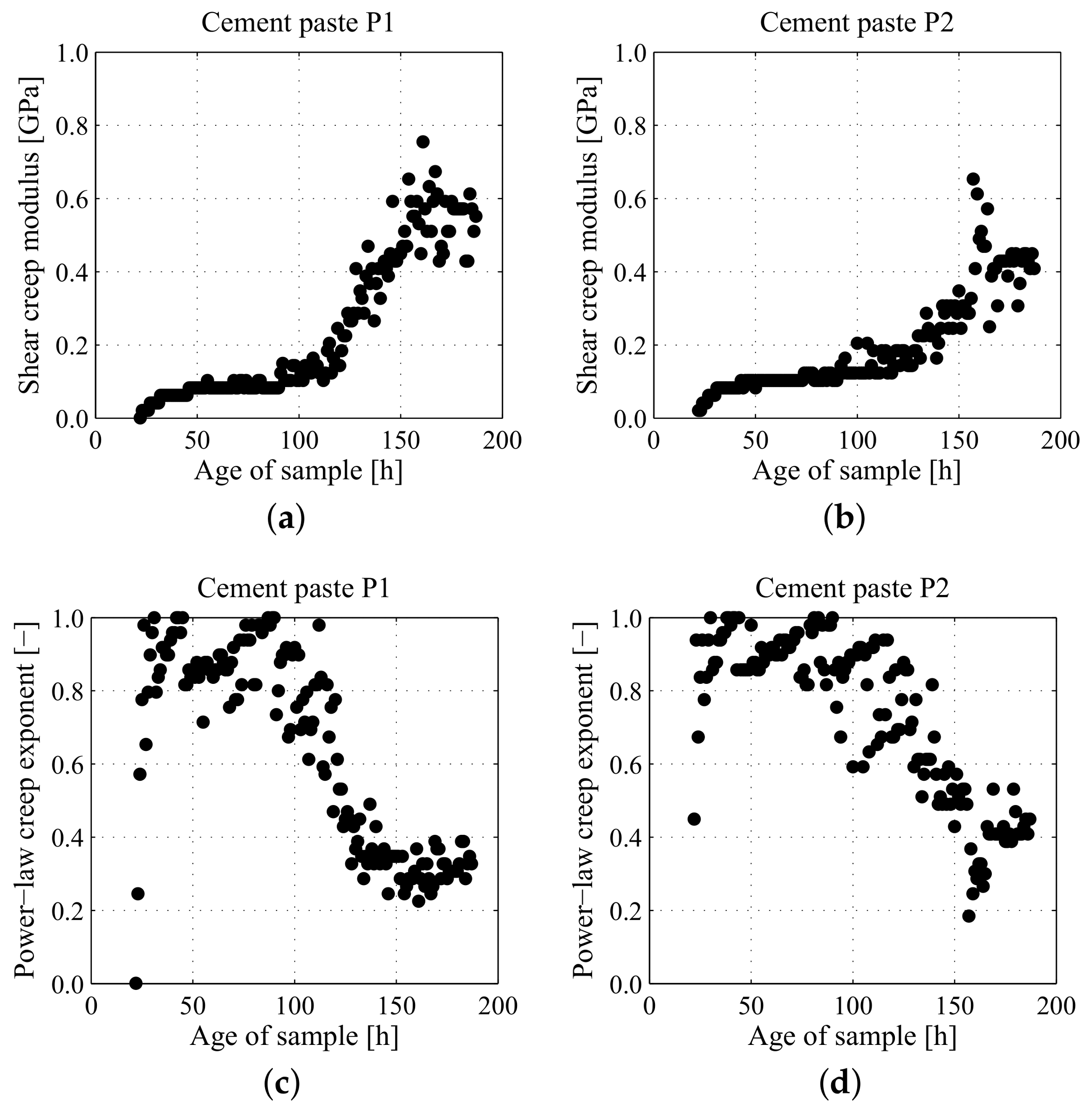
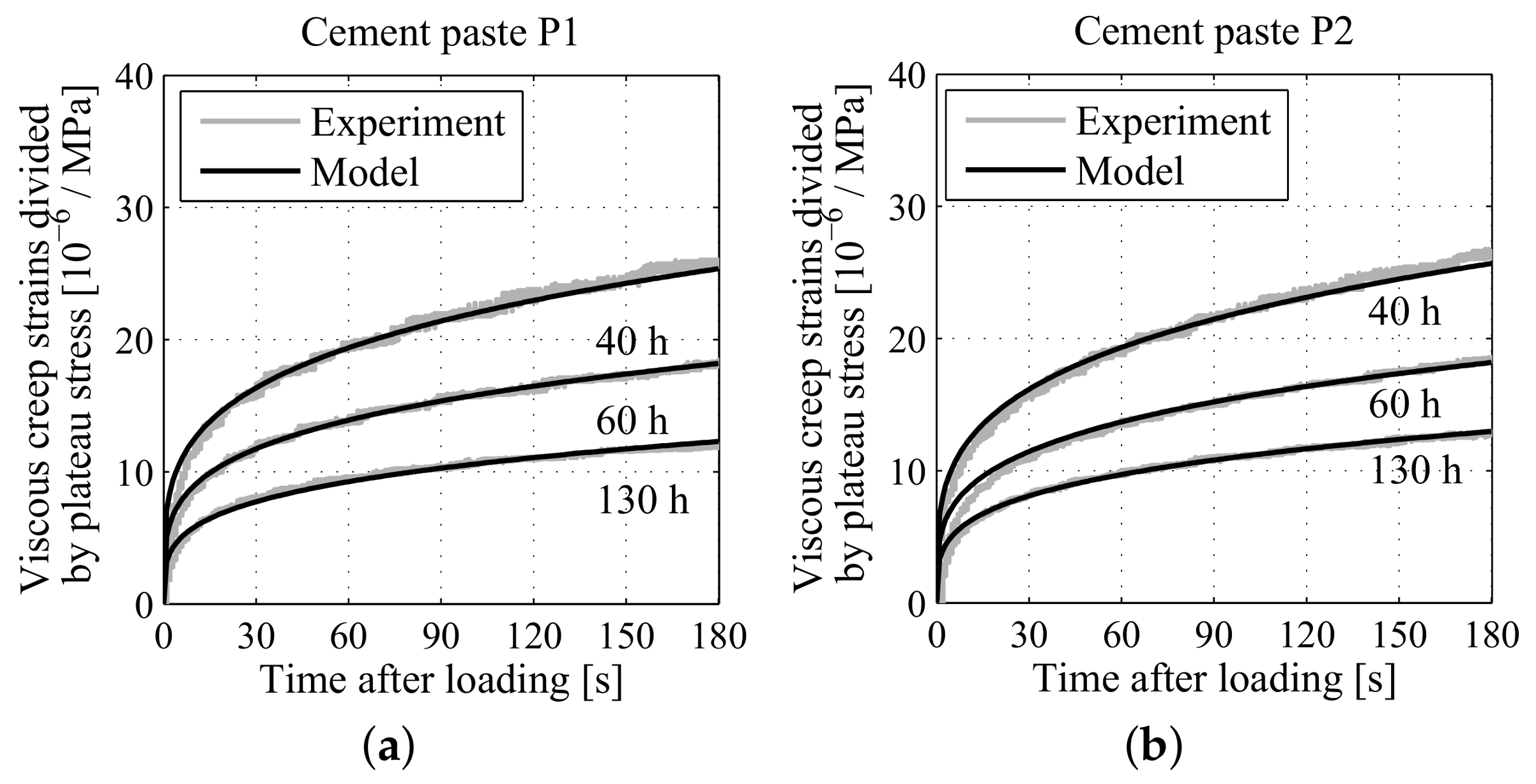
| Phase | Bulk Modulus | Shear Modulus | Mass Densities | Reference |
|---|---|---|---|---|
| (GPa) | (GPa) | (g cm) | ||
| Air | = 0 | = 0 | ||
| Water | = 0 | = 0 | ||
| Hydrates | = 18.69 | = 11.76 | [23,29,43] | |
| Cement | = 116.70 | = 53.80 | [33,44] | |
| Polymer P1 | = 3.97 | = 0.85 | [8,9] | |
| Polymer P2 | = 4.02 | = 0.86 | [8,9] |
| Shear Creep Modulus | Power-Law Creep Exponent | Polymer | Mean Error |
|---|---|---|---|
| universal | universal | P1 | |
| universal | universal | P2 | |
| age-dependent | universal | P1 | |
| age-dependent | universal | P2 | |
| age-dependent | age-dependent | P1 | |
| age-dependent | age-dependent | P2 |
© 2018 by the authors. Licensee MDPI, Basel, Switzerland. This article is an open access article distributed under the terms and conditions of the Creative Commons Attribution (CC BY) license (http://creativecommons.org/licenses/by/4.0/).
Share and Cite
Göbel, L.; Königsberger, M.; Osburg, A.; Pichler, B. Viscoelastic Behavior of Polymer-Modified Cement Pastes: Insight from Downscaling Short-Term Macroscopic Creep Tests by Means of Multiscale Modeling. Appl. Sci. 2018, 8, 487. https://doi.org/10.3390/app8040487
Göbel L, Königsberger M, Osburg A, Pichler B. Viscoelastic Behavior of Polymer-Modified Cement Pastes: Insight from Downscaling Short-Term Macroscopic Creep Tests by Means of Multiscale Modeling. Applied Sciences. 2018; 8(4):487. https://doi.org/10.3390/app8040487
Chicago/Turabian StyleGöbel, Luise, Markus Königsberger, Andrea Osburg, and Bernhard Pichler. 2018. "Viscoelastic Behavior of Polymer-Modified Cement Pastes: Insight from Downscaling Short-Term Macroscopic Creep Tests by Means of Multiscale Modeling" Applied Sciences 8, no. 4: 487. https://doi.org/10.3390/app8040487
APA StyleGöbel, L., Königsberger, M., Osburg, A., & Pichler, B. (2018). Viscoelastic Behavior of Polymer-Modified Cement Pastes: Insight from Downscaling Short-Term Macroscopic Creep Tests by Means of Multiscale Modeling. Applied Sciences, 8(4), 487. https://doi.org/10.3390/app8040487





